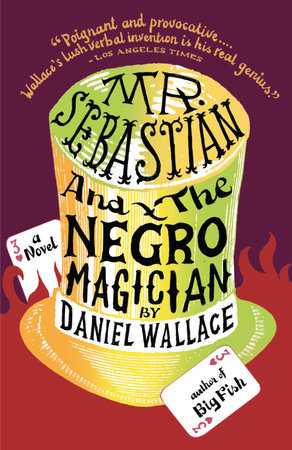Mr. Sebastian and the Negro Magician Reader’s Guide
By Daniel Wallace


1. Mr. Sebastian and the Negro Magician employs multiple narrators—JJ, Jeremiah Mosgrove, Jenny, and Carson Mulvaney, the private detective. There are also stories within stories, as when Rudy tells Henry’s story to Corliss, Jake, and Tarp. Why has Daniel Wallace chosen to fracture his narrative in this way? What are the advantages of telling a story from multiple points of view rather than from the perspective of a single, omniscient narrator?
2. The tension between truth and fiction, reality and illusion, runs through Mr. Sebastian and the Negro Magician, and the line between them is blurred again and again. Henry told his life story to Rudy, and the narrator observes that “every word he had told Rudy was true-not factual, but true” [p. 22]. How can a story be both “not factual” and “true”? Why is this theme of truth versus illusion so important in the novel?
3. Jeremiah Mosgrove describes Henry as “an American of the highest order: a self-made freak” [p. 84]. What does he mean by this? Why would being a “self-made freak” make one an “American of the highest order”?
4. Jenny says that, “In the end, Henry was a man with two stories: one story was about revenge, and the other was about love” [p. 131]. In what ways is Henry motivated by both revenge and love?
5. Mr. Sebastian makes Henry take the magician’s oath “not only to practice illusion, but to live within it, to seem but not to be…” [p. 185]. In what ways does Henry both practice and “live within” illusion?
6. In most instances of racial “passing,” blacks would try to pass for white. In Mr. Sebastian and the Negro Magician, Henry “passes” for a black man. What does the novel reveal about race relations in America during the 1950s?
7. Is Mr. Sebastian and the Negro Magician itself a kind of magic trick or series of illusions? In what ways are readers of the novel similar to an audience at a circus magic show?
8. What is the significance of Mr. Sebastian having a face as white as a sheet and Henry assuming the appearance of a black man? Is Mr. Sebastian the devil or merely a magician or con man?
9. What is the real fate of Henry’s sister Hannah? Did Henry make her disappear? Did Mr. Sebastian abduct her? Was she given to Mr. Sebastian by her father? Is she, in fact still alive at the end of the novel, sharing a home with Mr. Sebastian? Does the novel seem to support one of these possibilities over another?
10. What is the larger emotional significance of Henry’s bringing Marianne back to life?
11. What qualities does Mr. Sebastian and the Negro Magician share with magical realist works like Gabriel García Márquez’s One Hundred Years of Solitude, Isabel Allende’s The House of Spirits, Salman Rushdie’s Midnight’s Children, or Zadie Smith’s White Teeth? In what ways does Mr. Sebastian and the Negro Magician challenge conventional distinctions between reality and imagination?
12. In what ways does Henry’s family history shape the course of his life? How does his family and personal history intersect with America’s economic and racial history?
13. Jenny says that “Henry Walker is a hero, a tragic one” [p. 130]. What does she mean? In what sense is Henry’s life both heroic and tragic?
14. As the novel nears its end, Henry appears very close to death. How should readers interpret the novel’s final sentences: “Think Henry Walker: Just think it. That’s all he’d have to do and it would be done, and he would know” [p. 290]? Does Henry die or live on? What will be “done” and what will Henry “know”? What is Wallace suggesting here about the relationship between imagination and reality?
15. Circuses and magic shows are above all forms of entertainment. What makes Mr. Sebastian and the Negro Magician so entertaining?
Just for joining you’ll get personalized recommendations on your dashboard daily and features only for members.
Find Out More Join Now Sign In